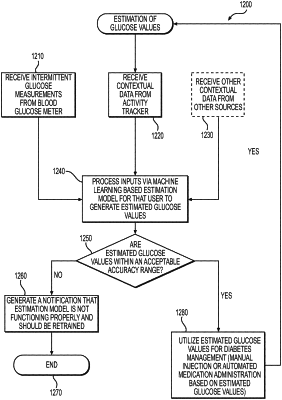| CPC A61B 5/7267 (2013.01) [A61B 5/1118 (2013.01); A61B 5/14532 (2013.01); A61B 5/4839 (2013.01); A61B 5/4866 (2013.01); A61B 5/7221 (2013.01); G16H 50/20 (2018.01); G16H 50/50 (2018.01); A61B 5/0002 (2013.01); G16H 20/17 (2018.01)] | 20 Claims |

|
1. A processor-implemented method, comprising:
receiving a first set of inputs comprising contextual activity data collected from a source of user activity data, and a second set of inputs comprising intermittent glucose measurements provided from a blood glucose meter; and
processing, via an estimation model, the first set of inputs and the second set of inputs to generate a set of estimated real-time glucose values without using information from a continuous glucose monitor, wherein the generated set of estimated real-time glucose values are not inputted into the estimation model, and the estimation model is an ensemble model that comprises: one or more machine learning models, and a physiological model, wherein the physiological model is configured to be used in conjunction with the one or more machine learning models to confine the generated set of estimated real-time glucose values within an acceptable range.
|